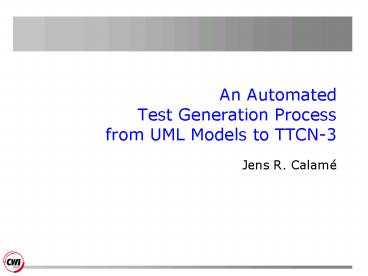An Automated Test Generation Process from UML Models to TTCN3 - PowerPoint PPT Presentation
Title:
An Automated Test Generation Process from UML Models to TTCN3
Description:
Abstracted system is an over-approximation of. original system ... Abstract test case (control flow ... Data abstraction algorithm is implemented for CRL ... – PowerPoint PPT presentation
Number of Views:50
Avg rating:3.0/5.0
Title: An Automated Test Generation Process from UML Models to TTCN3
1
An AutomatedTest Generation Processfrom UML
Models to TTCN-3
- Jens R. Calamé
2
Our Test Generation Process
System Specification (e.g. UML)
System Specification (formal)
Abstraction
Abstract System Specification
Test Case Generation
Test Purpose
TGV
Abstract Test Case
TTCN-3 Generation
Constraint Generation
Parameterizable Test Case (TTCN-3)
Rule System for Data Selection
3
Abstraction
- Motivation Test Generation with TGV is based on
enumerative techniques? suffers from state-space
explosion - Finite state-space by data abstraction
- System abstraction on specification-level
- Replace all input values by one constant chaos
() - Propagate this through the system
- Transform conditions based on to
nondeterministic choice? Abstracted system is an
over-approximation of original system
4
Generation of Data Selection Rules
- Given
- Abstract test case(control flow information
internal data) - Original specification (data dependencies)
- Result (generated Prolog implementation)
- Rules, representing ADT functions of the original
specification (meta language) - Rule system based on specification one rule for
each transition in original system, containing - Conditions
- Assignments (internally or from input actions,
resp.) - Test oracle based on abstract test case(query to
rule system) - Invocation of all selected actions as a
conjunction
5
Test Execution
- Pre-solve one trace to pass statically(skip
internal ?-steps) - Execute this trace until the SUT leaves it
- Try to find a trace to pass ? solve and execute
it - If no trace to passTry to find a trace to
inconc ? solve it - If no trace to inconcset test verdict fail
!initPin(x00)
!initBalance(x10)
2
0
1
!getPin(x20)
?pinInCorrect
3
INCONC
?pinCorrect
?lowBalance
4
!getAmount(x40)
!getBalance
5
7
PASS
?Money(x70)
?Balance(x50)
!getAmount(x60)
?eatCard
6
6
Future Work (Theoretical Part)
- Proof of completeness of the presented approach
- If there is a failure in the SUT is there a
test case that finds it? - ?-steps handling not yet fully satisfying
- In blackbox testing ?-steps are skipped
- However for online constraint-solving ?-steps
contain necessary information (e.g. internal
assignments) - Possible solution assignment collection in first
visible action after sequence of ?-steps (loops?) - Theoretical foundation of suspension handling
(quiescence, ?-loops again)
7
Conclusion
- Actual status
- Data abstraction algorithm is implemented for
µCRL - Parameterization constraint generation is
implemented - Whole test generation process is applied to
CEPS(but not yet test execution) - Generation of TTCN-3 test cases ongoing work
- Future work
- Correct handling of ?-steps in blackbox-testing
- Handling of suspension traces in the SUT
- Proof that a complete set of test cases is
generated - Test data selection and test case
parameterization - Formalization of UML-Models for test generation
8
(No Transcript)































